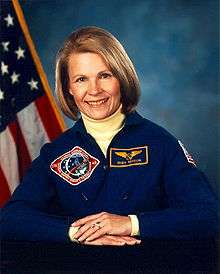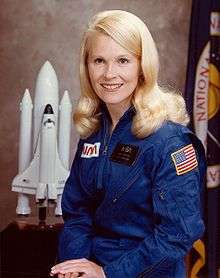Margaret Rhea Seddon
Margaret Rhea Seddon (born November 8, 1947) is a physician and retired NASA astronaut. After being selected as part of the first group of astronauts to include women, she flew on three Space Shuttle flights: as mission specialist for STS-51-D and STS-40, and as payload commander for STS-58. Both before and after her career in the astronaut program, she has been active in the medical community in Tennessee, Mississippi and Texas.
Margaret Rhea Seddon | |
|---|---|
 | |
| Born | November 8, 1947 |
| Status | Retired |
| Nationality | American |
| Occupation | Medical doctor |
| Space career | |
| NASA Astronaut | |
Time in space | 30d 02h 21m |
| Selection | 1978 NASA Group |
| Missions | STS-51-D, STS-40, STS-58 |
Mission insignia | |
Early life and education
Seddon was born in Murfreesboro, Tennessee, where she attended St Rose of Lima Catholic School and graduated from Central High School in 1965. She received a bachelor of arts degree in physiology from the University of California, Berkeley, in 1970, and a doctorate of medicine from the University of Tennessee College of Medicine in 1973. While at the University of California, Seddon was a member of Sigma Kappa sorority.[1]
After medical school, Seddon completed a surgical internship and 3 years of a general surgery residency in Memphis with a particular interest in nutrition in surgery patients. Between the period of her internship and residency, she served as an Emergency Department physician at a number of hospitals in Mississippi and Tennessee, and served in this capacity in the Houston area in her spare time. Seddon has also performed clinical research into the effects of radiation therapy on nutrition in cancer patients.
NASA experience
Selected as an astronaut candidate by NASA in January 1978, Seddon became an astronaut in August 1979. Her work at NASA was in a variety of areas, including Orbiter and payload software, Shuttle Avionics Integration Laboratory, Flight Data File, Shuttle medical kit and checklist, launch and landing rescue helicopter physician, support crew member for STS-6, crew equipment, membership on NASA's Aerospace Medical Advisory Committee, Technical Assistant to the Director of Flight Crew Operations, and Capsule Communicator (CAPCOM) in the Mission Control Center.[2][3]
She was Assistant to the Director of Flight Crew Operations for Shuttle/Mir Payloads. A three-flight veteran with over 722 hours in space, Seddon was a mission specialist on STS-51D (1985) and STS-40 (1991), and was the payload commander on STS-58 (1993). In September 1996, she was detailed by NASA to Vanderbilt University Medical School in Nashville, Tennessee. She assisted in the preparation of cardiovascular experiments which flew aboard Space Shuttle Columbia on the Neurolab Spacelab flight in April 1998. Seddon retired from NASA in November 1997. She is now the assistant Chief Medical Officer of the Vanderbilt Medical Group in Nashville, Tennessee.
Space flights

STS-51-D ( Discovery), April 12–19, 1985, was launched from and returned to land at the Kennedy Space Center, Florida. The crew deployed ANIK-C for Telesat of Canada, and Syncom IV-3 for the U.S. Navy. A malfunction in the Syncom spacecraft resulted in the first unscheduled spacewalk, rendezvous and proximity operations for the Space Shuttle in an attempt to activate the satellite using the Remote Manipulator System. Taking her Sigma Kappa sorority badge into space Seddon logged 168 hours in 109 Earth orbits,[4] and used her surgical skills to operate a bone saw to help build homemade repair tools for the satellite.[5]
STS-40 ( Columbia) Spacelab Life Sciences (SLS-1), June 5–14, 1991, a dedicated space and life sciences mission was launched from the Kennedy Space Center, Florida, and returned to land at Edwards Air Force Base, California. During the nine-day mission the crew performed experiments which explored how humans, animals and cells respond to microgravity and re-adapt to Earth's gravity on return. Other payloads included experiments designed to investigate materials science, plant biology and cosmic radiation, and tests of hardware proposed for the Space Station Freedom Health Maintenance Facility. Mission completed in 146 orbits of the Earth, and logged her an additional 218 hours in space.
STS-58 ( Columbia), Spacelab Life Sciences-2 (SLS-2), flew October 18 to November 1, 1993. Seddon was the Payload Commander on this life science research mission which received NASA management recognition as the most successful and efficient Spacelab flown to date. During the fourteen-day flight the seven-person crew performed neurovestibular, cardiovascular, cardiopulmonary, metabolic, and musculoskeletal medical experiments on themselves and 48 rats, expanding our knowledge of human and animal physiology both on earth and in space flight. In addition, the crew performed 10 engineering tests aboard the Orbiter Columbia and 9 Extended Duration Orbiter Medical Project experiments. The mission was accomplished in 225 orbits of the Earth in over 336 hours.
Personal life
She is married to former astronaut Robert L. Gibson of Cooperstown, New York, with whom she has three children.
Awards and honors
In 2015, Seddon was inducted into the United States Astronaut Hall of Fame.[6][7]
See also
References
| Wikimedia Commons has media related to Margaret Rhea Seddon. |
- "Significant Sigma Kappas". Sigma Kappa. Retrieved July 13, 2018.
- "Biographical Data: Margaret Rhea Seddon (M.D.)". NASA. November 1998. Retrieved July 13, 2018.
- Campbell, Doug (November 22, 1996). "Former NASA astronaut's skills, experience put to use at VUMC". Reporter. Vanderbilt University Medical Center. Retrieved July 13, 2018.
- "History of Sigma Kappa Sorority: Milestones". Sigma Kappa. Retrieved July 13, 2018.
- Walker, Charles D. (14 April 2005). "Oral History Transcript". NASA Johnson Space Center Oral History Project (Interview). Interviewed by Johnson, Sandra.
- "U.S. Astronaut Hall of Fame". Astronaut Scholarship Foundation. Retrieved March 23, 2018.
- Grinter, Kay (June 1, 2015). "Four NASA Heroes Inducted into U.S. Astronaut Hall of Fame" (Press release). NASA. Retrieved June 15, 2018.